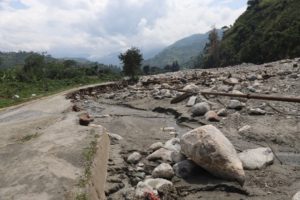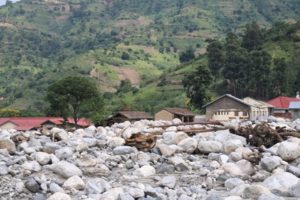Disastrous Floods in the Midst of the COVID-19 Pandemic in Kasese District of Uganda
By: Dr Yazidhi Bamutaze
Uganda’s disaster risk management capabilities and disaster resilience were put to the test in the first half of the year 2020. Uganda is a signatory to the Sendai Framework for Disaster Risk Reduction (SFDRR) (2015-2030) and has been steadily implementing measures to realise the key tenets of the SFDRR and promote a disaster resilient society. Uganda is prone to disasters due to its physical environment and the vulnerability of its population, but the number of hazards experienced between February and May 2020 was unprecedented, stretching ecological and social systems to their limits. These included the worst locust infestation in 70 years, record floods, and landslides, all occurring alongside the COVID-19 pandemic. The joint effects of flooding and COVID-19 were particularly severe in the Kasese District.
Kasese District is located in Western Uganda, and has a complex mixture of social and ecological vulnerabilities. As a mountainous region proximate to the African Rift it is prone to landslide and earthquake hazards, whilst the surrounding lowlands are also susceptible to flooding. Kasese District has one of the highest population densities in Uganda, and some of the most vulnerable populations.. Disaster risk issues therefore are prominent in this district in general, and particularly in the flood-prone lowlands.

Road and water supply system

School destroyed by the flood event
On the 8th of May 2020, at the peak of the COVID-19 lockdown measures implemented by Government of Uganda, severe floods impacted the Kasese District. This was followed by a recurrence of flooding just two days later. The flooding resulted in massive destruction to property including roads, bridges, schools and hospitals. Approximately 1,700 households or 9,000 people were displaced. 49,000 people were estimated to be flood affected. Fortunately, there were no fatalities recorded directly from the flood event, despite it occurring at night and requiring immediate evacuation of the lowlands. The timing of the flood event also meant that COVID-19 measures could not practically be implemented in the improvised shelter settings that accommodated evacuees.
It is notable that Kasese District had experienced a previous disastrous flood in 2013, and major infrastructure including roads, bridges and gabions had been reconstructed afterwards. Despite this reconstruction effort the impact of the 2020 flood was reportedly worse than the 2013 flood. This suggests that the ‘Building Back Better (BBB)’ principles, as envisioned under the SFDRR, were not realised. Secondly, any future recovery and reconstruction must take into consideration the co-occurrence of natural hazards with biohazards such as COVID-19 or Ebola, in order to enhance disaster resilience. Lastly this event did see some positive developments, particularly the increased participation of the private sector throughout the disaster response.
Author’s Bio:
 Dr Bamutaze holds a PhD (Geography), MSc (Geo-Information Science and Earth Observation), MA (Geography) and BA (Geography). He is working at Makerere University and holds the rank of Associate Professor in the Department of Geography, Geo-Informatics and Climatic Sciences (GGCS), Makerere University. Dr Bamutaze was the Chair, GGCS for four years (2015-2019) and is currently an elected member of University Senate representing the School of Forestry, Environment and Geographical Sciences. He has 21 years of education and research experience in academia at a university level, having joined the teaching service as a junior fellow at Makerere University in 1998. Dr Bamutaze developed the curriculum for the MSc Program on Disaster Risk Management currently running at Makerere University, and led its implementation. At Makerere University, he has championed research on disaster risk reduction and resilience.
Dr Bamutaze holds a PhD (Geography), MSc (Geo-Information Science and Earth Observation), MA (Geography) and BA (Geography). He is working at Makerere University and holds the rank of Associate Professor in the Department of Geography, Geo-Informatics and Climatic Sciences (GGCS), Makerere University. Dr Bamutaze was the Chair, GGCS for four years (2015-2019) and is currently an elected member of University Senate representing the School of Forestry, Environment and Geographical Sciences. He has 21 years of education and research experience in academia at a university level, having joined the teaching service as a junior fellow at Makerere University in 1998. Dr Bamutaze developed the curriculum for the MSc Program on Disaster Risk Management currently running at Makerere University, and led its implementation. At Makerere University, he has championed research on disaster risk reduction and resilience.

